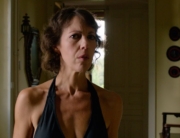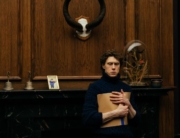Here’s a superhero sequel movie worth seeing! The Vogels, mild-mannered retirees Herb the postal worker and Dorothy the librarian, thrilled viewers in director Megumi Sasaki’s first documentary feature, Herb & Dorothy (2008), and won more admirers after it was shown on PBS’s Independent Lens the next year. All of us were curious to know: what happened to them after big trucks loaded up 5,000 conceptual and minimalist art pieces out of their one-bedroom Manhattan apartment and headed to the National Gallery of Art in Washington DC?
When we left the Vogels, they were still enthusiastically using their pensions and critical eyes to buy yet more small pieces from artists they cared for passionately, ones now well known, like Sol LeWitt and Christo, and many more they appreciated before the cognoscenti. Some of their 1992 donation is now stored in the Smithsonian’s Archives of American Art, where their scouting activities as collectors since 1960, including of every exhibit they attended, is being meticulously documented. (The National Gallery quickly realized that this unparalleled collection was just too large for even such a major institution to publicly exhibit, as the Vogels wanted.)
The genesis and implementation of the creative solution is pursued in fascinating detail. “The Dorothy and Herbert Vogel Collection: Fifty Works for Fifty States” (nicknamed “Vogel 50X50”) was launched in 2008 to distribute 2,500 of their artworks—drawings, paintings, objects, prints, and photographs by 177 artists—to museums they helped pick in each of the 50 states, institutions in diverse settings that wouldn’t have been able to acquire them. In an ironic twist for such contemporary works of American art, the senior curator explains the idea was inspired by the Samuel Kress Collections of European art, most of which is from the Renaissance. The patrician head of the Kress Foundation (also a donor to the film) describes that from 1929 the five-and dime-store magnate Samuel H. Kress donated thousands of pieces to more than 40 museums.
For the Vogels’ collection, each recipient is required to display their bounty within five years of receipt, and one of the treats is to see the Vogels check their progress, and what active donors they are—going to the exhibitions, checking their website daily for updates, and participating on panels. The film visits artist studios like the Vogels would. Artist Charles Clough remembers worrying about their purchase: “I’m thinking it’s going to go under their bed? Is it ever going to get seen?” The artists started out as skeptical about the national distribution as Herb, who for decades and until the end of his life preferred to talk to his fellow artists rather than museum curators.
One of the best scenes shows the Vogels perking up when the suburban Montclair (NJ) Art Museum’s curator involves them in her conception to have its allotment exhibited to reflect how the Vogels lived with their art. Wheelchair-bound Herb, who throughout the film becomes more and more frail, forcefully barks out definitive instructions to the picture hangers on how to line up the pieces in the recreation of their living room. Their story as a relatable couple who bought art they could afford and fit in their small apartment serves as a model for the Montclair Museum’s annual Collecting Art: Affordable Art Fair, where locals can get to know artists who offer work for under $500.
The film travels, sometimes with the Vogels, to more than 10 other museums, and one can almost sing some stirring patriotic song as the camera captures the varied contextual landscape around each—the Delaware Art Museum reviving downtown Wilmington; the Yellowstone Art Museum nestling in the Montana Rockies, the Speed Art Museum set in Louisville, Kentucky bluegrass; the amber waves of grain around the Plains Art Museum in Fargo, North Dakota; the palm trees shading the Honolulu Museum of Art. Administrators explain how the gift has moved them beyond their regional focus, and the docent volunteers look energized guiding the community and tourists through the collection, with varied audiences who are all new to conceptual art. There’s also an admission of one failure in the project, when the art museum in Las Vegas went under in the recession, and a surprised and delighted substitute accepts the transferred gift, though it seems odd that more mutual investigation about the hosts didn’t go on in the selection process.
The film takes a long look at each piece in the museums’ exhibits, with the artist labeled. Surprisingly, it’s clear that when the works were stuffed into their apartment, the Vogels always conceived of them as if they were individually hung in formal settings, even though it means that now their beloved works have to be handled with protective gloves.
The director follows the impact of Herb’s death in the summer of 2012 at age 89, and Dorothy’s announcement that she wouldn’t add more to their joint collection, leaving her with one painting, by her husband, and more time to watch over the project. An animated map showing all 50 locations made me wish that the more than 2,000 Kickstarter funders had enabled the film to document how more museums have experienced the impressive impact of this unique vision.







Leave A Comment